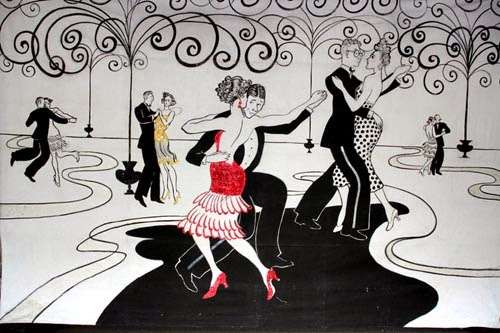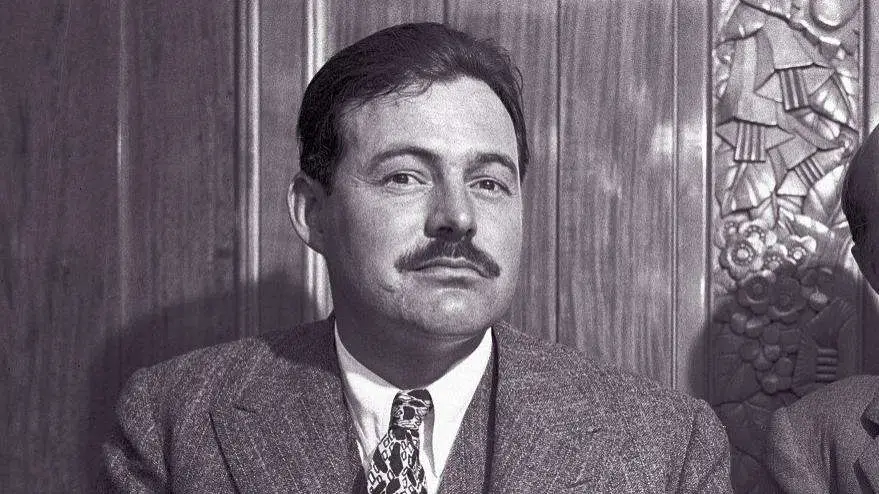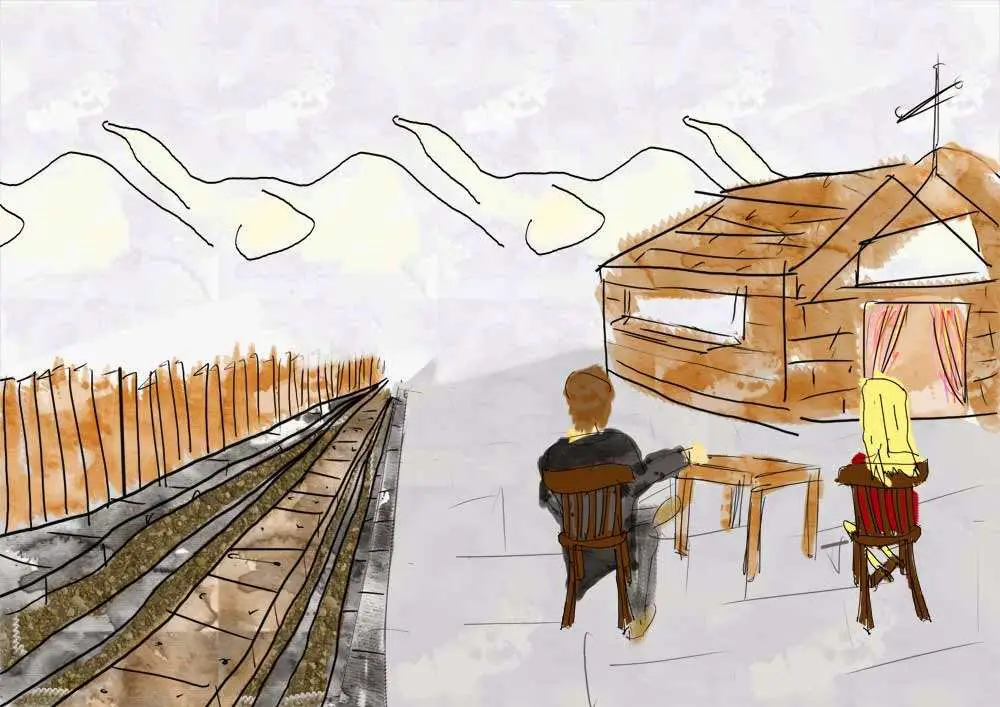Table of Contents
Summary : Hills Like White Elephants
In the early 1920s, an American man and a young woman, possibly nineteen or twenty years old, were waiting for an express train to take them to Madrid at a Spanish railway station. They sat in the sweltering shade, drinking beer, two licorice-tasting anis cocktails, and then more beer, discussing what the American man claims will be “an easy operation” for the lady.
The heat of the Spanish sun is almost as hot as the tension between the two. While pressing the girl to get the operation, the man repeatedly states that he does not want her to do it if she truly does not want to. He, on the other hand, is adamant that she do so. The girl tries to appear brave and unconcerned, but she is clearly afraid of committing to the operation. In the hopes of pleasing the man, she employs a conversational, fancy figure of speech, remarking that the hills beyond the train station “look like white elephants,” but he is irritated by her ruse. He persists in talking about the operation and how it’s “normal” and “not really an operation at all,” according to what he’s heard.
The fast train finally arrives, and the two get ready to board. “I’m alright,” the girl says to the man. She’s lying, acquiescing to his demands in the hopes of calming him down. Nothing has been figured out. As they prepare to leave for Madrid, the tension stays coiled and tight. The girl is stung by the man’s deceptive, patronizing empathy, and she is also terrified of the procedure she will have in Madrid.
Analysis: Hills Like White Elephants

Early editors turned down this story, and anthologists ignored it until recently. It was returned by the first editors because they mistook it for a “sketch” or an “anecdote,” rather than a short narrative. At first, editors tried to estimate what the reading public desired at the time, and at first, they felt compelled to buy works that told stories and had plots. “Hills Like White Elephants” isn’t a standard story, and it doesn’t have a plot.
Some of the story’s early rejection can be attributed to the fact that none of the editors who read it had any understanding of what was going on. Most readers are still perplexed by the narrative today. To put it another way, it will take a keen reader to notice right away that the couple is talking about the girl having an abortion during a time when abortions were strictly prohibited, deemed immoral, and often hazardous.
Related : Band Of Brothers, The True Story Of Easy Company In WW 2
Early critics of the story criticized the lack of standard characterizations as another point of contention. The female is simply referred to as “the girl,” while the male is just referred to as “the guy.” There are no details of either person’s physical appearance or attire. Unlike in traditional stories, when the author normally provides us some indications about how the main characters look, sound, or dress, we know nothing about “the man” or “the girl” in this one. We don’t know anything about their pasts. Can we make any assumptions about them, such as whether “the man” is older and “the girl” is younger, possibly eighteen or nineteen? The tone of “the girl” is one basis for adopting this bare-bones conjecture. Her questions are not those of a knowledgeable, mature lady, but rather those of a young woman wanting to please the man she is with.
It’s a miracle that this piece was ever published. Authors were supposed to lead readers through a story at the time it was written. Hemingway, on the other hand, fully removes himself from the story in “Hills Like White Elephants.” The voice of the author is never heard by the reader. When compared to the typical nineteenth-century approach of narrating a story, this narrative strategy is more effective. Back then, authors like Dickens and Trollope would frequently address their audience directly.
Business Guide : Need To Sell House Fast For Cash? Wait! Read This
On the other hand, we have no idea how to react to Hemingway’s characters. We could more easily relate to these characters if Hemingway had said that the girl spoke “sarcastically,” “bitterly,” or “angrily,” or that she was “puzzled” or “indifferent,” or that the man spoke with “an air of superiority.” Hemingway, on the other hand, distances himself from them and their activities to the point where he appears to know little about them. The nickname “Jig” appears to have come about by chance.
This narrative, however, became one of the most anthologized of Hemingway’s short stories throughout the latter part of the 1990s. Hemingway’s use of conversation to express the “meaning” of the story—that is, there is no description, narration, or identification of character or intent—is part of this new appreciation for the story. We have no clear understanding of what the topic of conversation is (abortion), but the dialogue conveys what we know about the characters.

Furthermore, the popularity of this story can be traced back to a shift in reader expectations. Readers in the 1990s had grown accustomed to reading between the lines of fiction and didn’t want to be told everything about the characters in minute detail. They admired Hemingway’s refusal to say whether or not the two protagonists are married. He just shows their chat and leaves his readers to make their own judgments. As a result, readers are likely to presume that these two people are not married; but, if we’re interested enough in them to guess, we must consider how marriage would impact their lives. And, in order to address this question, we must take note of one of the story’s few details: their luggage. “Labels from all the hotels where they had spent nights” are on their bags. If these two individuals, the man and the woman, have this child, their endless wanderings may have to come to an end, and they may have to start a new life for themselves; they may also have to decide whether or not to marry and legalize the child. A kid and marriage would impose significant adjustments on their lives, given their supposedly carefree lifestyle and desire for independence.
Related : Band Of Brothers, The True Story Of Easy Company In WW 2
Everything in the article suggests that the man is adamant about the girl having an abortion. We doubt the man’s sincerity and honesty even when he claims that he only wants the girl to have an abortion if she wants one. When he declares, “You are not obligated to do so if you do not choose to.” If you didn’t want to do it, I wouldn’t make you do it. “He does not persuade me. From his previous words, it is clear that he does not want the responsibilities that having a child would involve; he appears to be adamant that she have the abortion and appears to be completely indifferent to the girl’s sentiments.
On the other hand, we believe the girl is undecided about having an abortion. She’s undecided about her decision. We sense that she is tired of traveling, of allowing the man to make all of the decisions, and of allowing him to talk nonstop until he persuades her that his way is the right way. He has taken on the role of her guide and protector. Even now, he translates for her: An abortion is as simple as a doctor allowing “a little air in.” They’ll then embark on fresh adventures. For the girl, though, the constant flux of living in motels, traveling, and never settling down has grown exhausting. “[We] gaze at stuff and try new drinks,” the girl says, describing their life of transience and volatility as “living on the surface.”
We recognize the man’s insincerity when he offers to be with the girl during the “easy” operation, because what is “easy” to him may be emotionally and physically harmful to her.
Business Guide : Need To Sell House Fast For Cash? Wait! Read This
The man is employing arguments to persuade as many people as possible. They can continue to travel without a baby to anchor them; they can “have it all.” The girl, on the other hand, contradicts him and appears unexpectedly strong and in command of the situation. Things will never be the same again, abortion or no abortion. She also understands that she isn’t loved in the way she thinks she is, at least not unconditionally.
You can buy book
As a result, we arrive at the story’s title. When the girl saw the mountains, she stated they looked “like white elephants.” The two become increasingly tense until the man says, “Oh, cut it out.” She claims he began the quarrel, then apologizes, claiming that the mountains don’t truly seem like white elephants-they’re just “their skin through the trees.”
The hills don’t resemble white elephants, and they certainly don’t have skins, according to the man. The girl, on the other hand, has moved away from the man’s rational world and into her own intuitive realm, where she appears to know that the things she desires will never be realized. When she looks across the river, she sees fields of fertile grain and the river — the land’s fertility, in contrast to the barren sterility of the hills like white elephants. Of course, she longs for the beauty, loveliness, and fertility of the grain fields, but she understands that she must make do with the barren sterility of an impending abortion and the prolonged presence of an insufficient man. The tale does not reveal what she will do in the end.
During the brief interactions between the man and the girl, she transforms from someone who is nearly entirely reliant on him to someone who is more confident in herself and knows what to anticipate from him. She regains control of herself and the situation towards the end of their conversation; she no longer acts childishly. She requests the man to kindly quiet talk — and the word “please” appears seven times, signifying that she is sick of his hypocrisy and constant harping on the same subject.
The Bottom Line :
In the early 1920s, an American man and a young woman, possibly nineteen or twenty years old, were waiting for an express train to take them to Madrid at a Spanish railway station. The girl tries to appear brave and unconcerned, but she is clearly afraid of committing to the operation. In the hopes of pleasing the man, she remarks that the hills beyond the train station “look like white elephants”. Analysis: Hills Like White Elephants Hemingway, on the other hand, fully removes himself from the story in “Hills Like White Elephants.” Hemingway’s use of conversation to express the “meaning” of the story is part of a shift in reader expectations. The author doesn’t say whether or not the two protagonists are married, and leaves his readers to make their own judgments.
We doubt the man’s sincerity and honesty even when he says he only wants the girl to have an abortion if she wants one. He does not want the responsibilities that having a child would involve; he appears to be adamant that she have the abortion. For the girl, though, the constant flux of living in motels, traveling and never settling down has grown exhausting. When the girl saw the mountains, she stated they looked “like white elephants.”
Source : Wikipedia | Cliffs notes
All the information & photo credit goes to respective authorities. DM for removal please.


